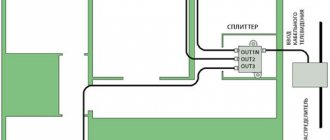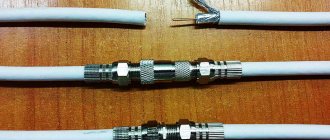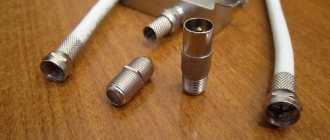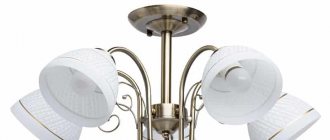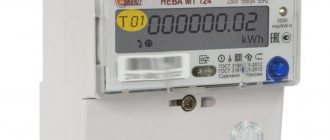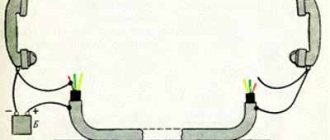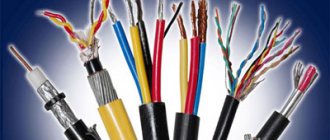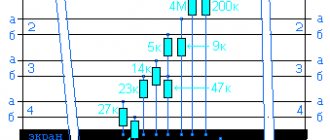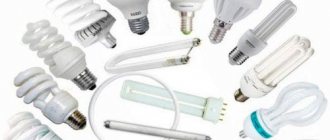A TV splitter is a special antenna divider. They are used in cases where there is more than one TV in the room and the signal needs to be distributed consistently between different consumers. A television splitter with an amplifier can serve a large number of devices at once (from 3 and above).
And if we talk about such devices, in general, they are necessary for frequency separation of channels. And also such devices additionally have built-in protection against incorrect pulse voltages and currents that may arise in the cable cores during a thunderstorm. The splitter also protects against interference from power transmission lines and contact networks of electric vehicles.
Dividers or splitters for television cable
If you only have one TV connected in your house, then there are usually no problems. In this case, the television signal enters the television receiver directly from the antenna. The problem comes when you want to watch two or more TVs. You don't have to buy a separate antenna for each of them. A TV cable splitter will come to the rescue - a small-sized device that will completely solve this problem.
The “magic” foreign words “splitter” and “diplexer” are called, respectively, an ordinary antenna splitter for digital television or a combiner of two different signals. Among cable operators, these devices are often referred to as “crabs.”
What is an antenna divider?
As the name suggests, an antenna splitter is a device consisting of a compact metal housing with several cable connectors, which serves to distribute the signal to several receivers. Not all splitters perform the same function, so they are grouped together.
Dividers (splitters)
The TV signal is evenly distributed to the required number of outputs. Indispensable in home cabling. The most popular type of television accessories among consumers. The main dividers that can be found in stores.
OCouplers
Sometimes the signal needs to be divided so that the main part of it is sent to one output (OUT), and the small remaining part is sent to a tap (TAP), where the signal will be much weaker than at the main output, where the main part goes. In the future, the same coupler can be connected to this main output, and the signal quality will not be lost. This type of divider is used in daily practice by cable TV providers when installing multi-apartment television networks. A band blocker or cable plug, a type of tap, works on the same principle, which can be useful when separating free and paid channels.
Adders (diplexers)
Of practical interest is an antenna divider capable of conducting a signal in the opposite direction and thus summing it. Combiners are able to mix signals from several wave receivers with different frequency characteristics into one cable. That is, you can sum up satellite and cable or digital television.
AActive or passive?
From the point of view of electrical parameters, a TV splitter can be passive or active. The first simply splits the signal into two or more outputs, with the significant advantage that it does not require an external power supply. If the incoming signal is strong enough, passive dividers work great without amplification, especially if it is a two-output splitter.
An active splitter is identical in design to a passive one, but differs in the presence of a small built-in amplifier, the task of which is to compensate for the loss of air quality caused by the separation. Splitters with an amplifier require a power supply for the chip. The range of these devices is represented by dividers with the ability to pass the supply voltage. This type of splitter is used when the incoming signal is uncertain or the antenna cable to the TV is long.
What are there
The following manufacturers have proven themselves well in this area: Lans, Rexant, Premier, Alda, Hama, Sat. At the output, they always give a higher quality signal than Chinese or home-made ones.
The best splitters are those that include transformers with high resistance and higher frequency. But they are quite expensive and technologically weak. Typically, they are only able to split the signal in two directions. When you need more, a splitter with resistors in series would be a good solution.
There are television crabs with 2, 3, 4, 6 or 8 outputs under the F connector for general and satellite television. They are characterized by high throughput.
Popular TV splitters:
- RTM type SAH 204F. 2-way splitter (isolation 28 dB, pass loss 3.6 dB).
- TLC type SAH 306F. Directions - 3 (isolation 28 dB, transmission loss 5.8 dB).
- Tbtec type HST 0408/F. 4-way splitter (isolation 32 dB, pass loss 7.2 dB).
The power division ratio can be equal (in most cases) or unequal.
How do dividers work?
Don't even think about simply connecting two parallel cables to the antenna and getting another signal source. Is it really not possible to connect antenna cables in a simple way? The law doesn't prohibit it, but it's impossible.
Divider circuit and board
An antenna cable, like any other, has a characteristic called “wave impedance.” The cable has its own characteristic impedance, calculated by the designers, so it should only be connected to an object that has the same characteristic impedance. Any attempt to connect the cable “to just about anything” leads to the fact that the main part of the signal, having reached the end of the cable, does not arrive at an object with a different characteristic impedance value, but instead is reflected and goes back along the coax.
The signal will not travel from the cable to an object with the “wrong” characteristic impedance. That is why, instead of a primitive, incorrect connection in the form of twisting, you need to use a coaxial cable splitter, or an antenna signal combiner, with a well-calculated characteristic impedance, the same as that of the cable. Unfortunately, the output signal divided into several receivers has a slightly reduced level.
Knowing how your divider works will help reduce troubleshooting time. For example, if the picture on the screen is torn, it is advisable to start searching for the causes by diagnosing faults in the signal source. You need to check the cable connectors of the splitter and the cable insulation. No metal parts of the cable shield should touch the cable core or clamp.
Splitters rating
The presence of several televisions and one antenna in the house requires the installation of a special adapter that will distribute the signal to the devices. It is impossible to simply separate the antenna cable, since in this case the wave impedance will be broken and, as a result, the signal will practically not reach the consumer. Then a special TV splitter is used. This is a small divider that performs the function of frequency separation of channels. The device can be equipped with an amplifier, thanks to which distribution will be available to three or more televisions. Also, most splitters are protected against surges in current or voltage.
Antenna splitters are easy to install. Any user can install them. To do this, you need to fix the device on the surface, remove the protective plugs from it, connect the coaxial cable to the TV and into the socket, and then connect the common TV cable. The whole process will not take much time, and errors during its implementation are practically eliminated.
It is difficult for an inexperienced user to choose a splitter, since these devices are characterized by many parameters and depend on several criteria. To make the task easier, our specialists from the VyborExperta.ru project have developed their own rating of antenna cable splitters for several TV consumers. The nominees made it to the top based on the following indicators:
- Purpose;
- Frequency characteristics;
- Number of consumers;
- Cable section.
The rating is based on reviews from real customers, expert reviews, and technical characteristics of the products themselves. All presented models are available to the average buyer.
How to choose the right splitter for TV
When buying a TV antenna splitter, the first thing you need to pay attention to is the number of output ports. If there are three television receivers in the house to which you want to connect the television signal and divide it, then, of course, you will need a splitter with three outputs. This is its main visual characteristic and you can hardly go wrong. A reasonable solution would be to buy a divider with an additional output, so to speak for the future.
Domestic and foreign manufacturers supply the market with a lot of splitters, from a double divider to a 16-port splitter. Their housing contains markings indicating the operating frequency range and the designation of inputs and outputs. Check whether the selected microdevice supports the required frequencies? The most common operating range is 5-860 MHz, which makes it easy to distribute a DVB-T2 television signal while maintaining broadcast quality. The channel frequency display function on your TV will help you not to make a mistake with the frequencies. The maximum frequency of one of the channels must fall within the frequency range of the divider.
Take a look at the selected divider from the aesthetic side. The geometry and dimensions of this device can be different; it’s up to you to decide whether to put it on display or give it an inconspicuous place. If you plan to mount it on a wall, you need a housing with mounting holes.
Those craftsmen who decide to make television wiring in their home themselves may be tempted to create a crab with their own hands. Technically, this is not difficult if you understand what the divisor consists of. But even if you have the necessary transformers and capacitors in your arsenal, as well as the housing of the future divider, do not complicate your life. Your product will only serve an analog signal, and may be useless for satellite and digital TV. But purchasing ready-made “crab” from leading manufacturers is a reliable and long-term solution.
Source
All about TV signal divider
We will send the material by email
Sometimes there are several TVs in an apartment. The incoming signal is distributed between them. At the same time, it is necessary to ensure the highest possible quality of video and audio on each of them. To fully use a TV signal divider, you should understand the principles of its operation and understand how to choose it correctly.
Varieties
Various types of structures are used, each of which has its own characteristics. When choosing, you need to take into account that the preference depends on the tasks facing the user.
Splitter
This device divides the incoming signal into the required number of consumers. At the same time, its characteristics change accordingly. This can be illustrated with the following example. If the input signal has a level of 12 dB, then when divided into two TVs, each of them will receive 6 dB. For three, this value will be equal to 4 dB.
Couplers
This design is used for signal conversion in apartment buildings. At the same time, it is distributed to each floor by splitters. And then to each apartment using taps. Here, two outputs are usually used, and the signal on one of them is more powerful. The latter can be used to connect another similar device. The cable from the weaker output will be used to transmit the signal to the apartment.
Adders
They can be used to simultaneously work with terrestrial and digital channels. It can only work with two consumers. If one of the receiving devices is disabled, it will still be possible to use the other.
TV crab installation
At the junction of the cables and the branching device, fixation is carried out with special nuts that come complete with the divider or adder. The other ends of the cables must be fitted with plugs. To do this, each wire must be stripped of insulation and the plug must be put on so that the central wire of the cable protrudes from it.
It can then be connected to your TV. After turning it on, you should search for channels and check the quality of the resulting sound and image for noise.
If the condition is satisfactory or poor, then you need to install an amplifier. In the age of digital technology, the question of how to connect TVs to a computer or other device is becoming increasingly common.
This will allow you to view photos, videos, website pages on a large television screen. Walking past shelves of monitors in a computer store, you may notice that they all play the same video or image.
An HDMI splitter is used for this purpose. Let's look at how to connect an active hdmi signal splitter to 2 TVs.
To do this, you will need a device with two outputs (OUT). If you need to connect more monitors, you should purchase an HDMI splitter with 4, 8 or 16 outputs (OUT).
Connection is quite simple. The HDMI cable from a computer or laptop must be connected to the input (IN), and the cables from monitors must be connected to the outputs (OUT).
How to choose
It is important to understand that the more receiving devices, the more the incoming signal will weaken. This is acceptable in cases where it is initially high. If this is not the case, then you need to choose an active antenna splitter. It is advisable to install it next to the receiving antenna.
First you need to determine the required device parameters. To do this, go to the settings and look at the frequencies of the channels used. It is important that the upper threshold of the range is above this frequency.
You need to take into account the number of television receivers available and think about whether you plan to buy new equipment. If this is the case, then splitter outputs must also be provided for them. Their quantity in the purchased device must correspond.
When purchasing, you need to evaluate the appearance of the device. If you plan to place it in a special box, then you need to select the dimensions so that it can fit there.
The TV body may have a place to mount the device. If they plan to fix it here, the splitter needs to match it. It is unacceptable to attach it in such a way that it dangles freely.
When purchasing, you need to determine the types of connectors available. They must match the existing cables. Having made your choice, it is recommended to look on the Internet to see which models are suitable. If necessary, you should prefer an active splitter.
How to choose a splitter
The range of splitters for TV is varied. Devices differ in operating frequencies, connector type, Internet support and other important characteristics that need to be taken into account when choosing. When choosing a splitter, you need to be guided by such criteria as the frequency of channels, the number of television receivers, and the diameter of the cable. Typically, information with technical characteristics is indicated on a sticker on the top of the device.
Purpose
The main function of a splitter is to distribute a television signal between several consumers without loss of quality. Television in the home can be organized in different ways - from an antenna, cable or satellite. This affects the choice of frequency. Separators can also be used for Internet distribution.
Channel frequency characteristics
Frequency is the main criterion for choosing a splitter. A television signal from an antenna or cable produces an on-air signal with a frequency of 5-1000 MHz. If you use satellite TV at home, you need a device operating in a bandwidth from 5 to 2500 MHz.
You can find out the frequency through the TV menu. From the obtained values, you need to determine the highest frequency and select a splitter in such a way that its limit value is higher.
Number of TV receivers
A classic antenna splitter is capable of distributing TV to up to eight receivers. Devices with 2, 3, 4, 6, 8 contacts are popular. The equipment is selected in advance depending on how many TVs are used in the home. If the residents of the house are planning to buy another TV, you can choose a device with a large number of outputs - the quality of the transmitted image will not deteriorate. But then it is recommended to “mute” the unused outputs with a resistor, which will absorb excess voltage. It is better to choose a resistor with a resistance of up to 75 Ohms.
Cable diameter
How the installation will be carried out depends on this indicator. You need to know the cable cross-section to select the appropriate splitter. When the device is selected, you need to decide on the installation method. There are several of them:
- Screw splitters are suitable for cables of any diameter. Easy to install without soldering.
- Model with threaded connection. Suitable for thin wires only. No soldering required.
- Devices equipped with a coaxial jack. Connects to any cables via an antenna plug.
- Splitters supporting soldering. The connection is carried out only by a specialist who ensures high-quality soldering.
Additional criteria
To ensure high-quality stable operation, the device can be equipped with a high-frequency transformer with high resistance. Such models are expensive and can only work with two television receivers. For three or more TVs, splitters equipped with resistors installed in series are selected.
The level of attenuation is taken into account. This parameter is indicated on the characteristics sticker. You should choose a product with a lower value. Appearance is taken into account during external installation, when the splitter will be visible. Dimensions must be taken into account for installation in a special box with cables.
Mounting method. The splitter can be left hanging on the wires, but this is not the most reliable way. The risk of damage or accidental removal then increases, so experts advise fixing it to the surface. Then select a model equipped with holes for fasteners.
Also, when choosing a splitter, it is important not to confuse it with other types of antenna devices, for example, with couplers. They perform different functions, therefore, they are selected according to different indicators.
Principle of operation
At first glance, it may seem that you can directly connect several output cables to an input cable. In fact, although this will work, it will make the signal so low quality that it will be impossible to watch.
The fact is that each cable has a certain characteristic impedance. They will be different for the input and output. If they are connected to another using twisting, then part of the signal will pass through it, and most of it will be reflected. The device is designed in such a way that the loss of quality during transmission is minimal. An active antenna TV splitter can completely compensate for the loss of signal quality.
Using dividers in an apartment
It is necessary to pay attention to the location of devices inside the apartment. The installation rules depend on the connection structure. It can be equilibrium or nonequilibrium. It is convenient to illustrate this with the following example.
The television signal enters the apartment via one cable. The receivers are at the same distance from him. In this case, you can use a simple divisor. Which will divide the input signal into several identical ones.
If the TVs are located at different distances from the input cable, the connections will have different lengths. Thus, the closest signal will be of the highest quality, and the most distant signal will be of the least quality. There is a nonequilibrium structure here.
In this case, a coupler is used that will split the signal into two, one of which is strong and the other relatively weak. The last one is for the nearest TV receiver, and the other is for the next coupler. This scheme will allow you to get maximum video and audio quality on all available devices. Splitters will allow you to redistribute the power of the input signal.
When using a splitter, you must choose a suitable location for it. It is important to keep the cable length to a minimum. When using three or more TVs, the signal is expected to become quite weak. This will allow you to watch analogue channels, but not digital ones.
For the latter, high signal quality is critical. In this case, it is recommended to use an active splitter. It will enhance the input signal to the required extent. It should be taken into account that signal amplification can also be done immediately after the antenna.
The more outputs the divider has, the stronger the attenuation will be. Therefore, it is not recommended to purchase a device that has more sockets for connection than necessary. If there are only two TVs, it is not recommended to take the device for 3 or more television receivers. When using it, not only signal weakening can occur, but also image ghosting. The latter is due to the presence of empty connectors. To avoid this effect, a plug with a resistance of 75 Ohms is placed on the free connector, which simulates a connected load.
How to connect
The instructions for connecting the splitter are quite simple:
- select a location and attach the divider to it;
- Next, you need to remove the plug from the antenna splitter (do this operation for each connector);
- use a coaxial cable (adapter) to connect the input to the TV and the jack;
- connect the television cable entering the apartment.
At this point the installation can be considered complete; installation takes no more than 10 minutes.

